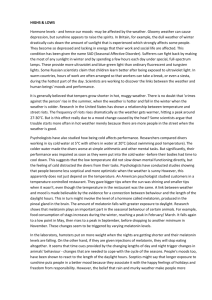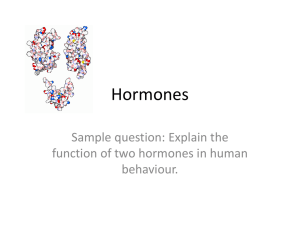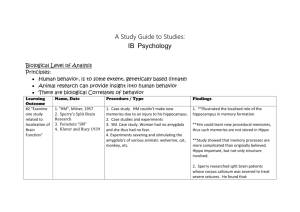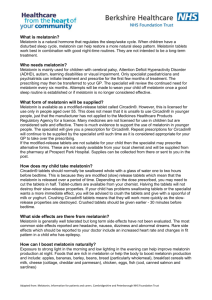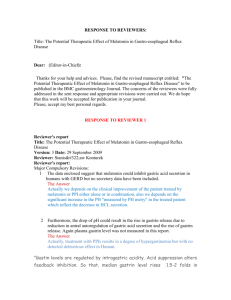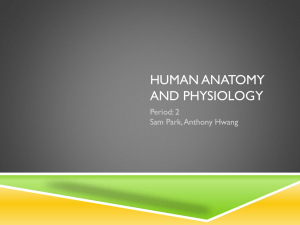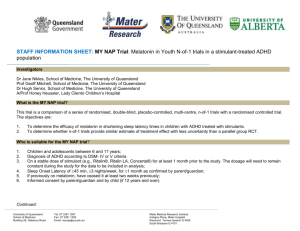Scientific References
advertisement
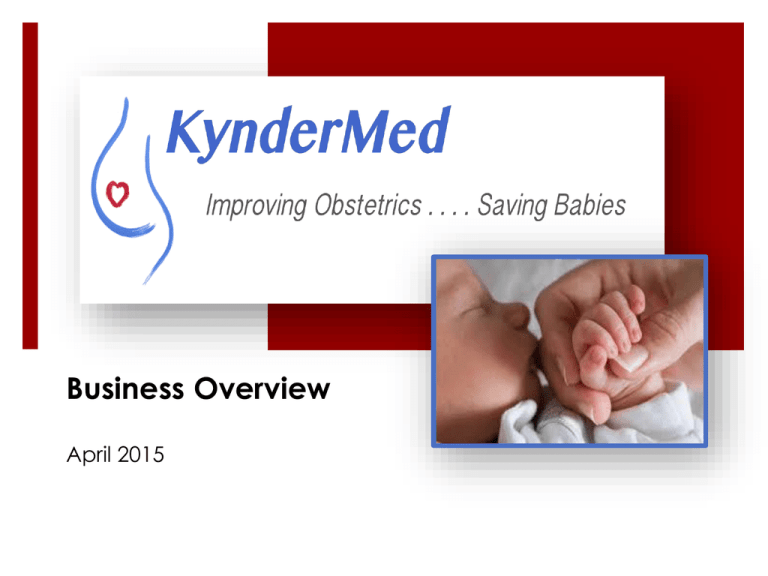
Business Overview April 2015 KynderMed Legal Disclaimers No Offer or Solicitation. Our presentation of the information contained herein shall not constitute an offer to sell, or solicitation of an offer to buy, any of our securities. Plans, Performance, Estimates and Assumptions. This presentation contains information concerning our future plans and performance. There can be no assurance that we will be able to successfully implement any of our plans or achieve any projected future performance. You should note that information concerning our future plans and performance involves known and unknown risks and uncertainties, many of which are beyond our control, and, accordingly, there can be no assurance that the information concerning our future plans and performance contained in this presentation will occur. Furthermore, because this presentation is based upon estimates and assumptions about circumstances and events that have not taken place and are subject to material variation, there can be no assurance that the matters, strategies, goals and expectations expressed in or implied by this presentation will be attained, or, if attained, that we will be profitable. Likewise, there can be no assurance that our estimates, assumptions, matters, strategies, goals and expectations will not change from those presented herein. This presentation was not prepared, and is not required to be prepared, in conformity with guidelines established by the U.S. Securities and Exchange Commission or any state securities regulatory agency or authority and has not been reviewed by an accounting firm. 2 KynderMed Our Mission: Saving Infants Focused on unmet medical needs in Obstetrics “An innovation wasteland” IP estate includes both pharmaceutical and device applications covering the regulation of uterine contractions First product is a medical device to delay the onset of premature labor. The product will be launch-ready in 2nd – 3rd Quarter of 2017 One human Proof of Concept completed Second in progress at Brigham and Women’s Hospital Third commencing in March Funding Need: $4 million $1.2 million now to complete 1st small pivotal trial $2.8 million in 16 months to reach US and EU marketing approvals 3 KynderMed 1,000,000 Preterm Babies Die Globally Each Year Tragic Human Toll Preterm birth: Number 1 cause of death for newborns. 1 in 8 pregnancies deliver preterm 25% of all US pregnancies are at-risk 35% of all infant deaths in the US are preterm Over 50% of the survivors born before 28 weeks will have long term problems Major Burden on an Overtaxed Healthcare System $25+ billion in US healthcare costs $55,000 average cost of care for a preemie 4 KynderMed And There is No Effective Therapeutic Answer Evidence: There has been No reduction in the incidence over the last 40 years . . . “an innovation wasteland Current Therapies: Pharmaceutical • • • Magnesium Sulfate Nifedipine Progesterone Surgical – Cerclage Short term Unsafe for mother and/or fetus The Outlook: Not Good Therapies in research are either short term solutions or early stage and will require a long time to reach the market 5 KynderMed The Importance of Reaching Full-Term GESTATION PERIOD : THE DIFFERENCE A WEEK OR A DAY CAN MAKE Week 21 22 23 Chance of Survival 0% 0-5% 10-35% 24 40-70% 50-80% Survival Increase 6% / day Long Term Problems 35-50% have one or more : Problems at Birth 25 4% / day • • • • Cerebral Palsy Blindness Deafness Intellectual Disability • • • • Breathing Ea ng Muscle tone Temperature 26 27 30 80-90% >90% >95% 2-3% / day 34 >98% >99% 1-2% / day 30% severe problems Increased risk of: • Learning Disabili es 50% some problems • Hearing • Sight • Intellectual (45%) • Behavioral Issues • • • • • Breathing • Ea ng Breathing Ea ng Muscle tone Temperature 6 40 KynderMed Creating a Solution Dr. Olcese’s Question Dr. James Olcese Expert in circadian rhythms and neuroendocrine mechanisms 100+ peer-reviewed papers Assoc. Professor of Biomedical Sciences, Neuroscience and Biophysics at FSU School of Medicine Formerly Professor, Hormone & Fertility Research at the University of Hamburg Medical School Being observant, noted that most deliveries occur at night Being curious, he asked OB/GYNs why . . . They did not know. Being a scientist he could not accept that and set off to find the answer 7 KynderMed The Science Background The Central Circadian Clock directs the timing of labor • Lesions of the central circadian clock (SCN) disrupt the timing of that parturition in the rat of revealed elimination Experiments with pregnant rats the “time of day signals” by surgically destroying the brain’s clock resulted in deliveries across 24h. Melatonin restores proper phase of parturition to pinealectomized rats • When melatonin was replaced to coincide with its normal rise the normal birth phase of the rats was restored. Reppert SM, et al 1987 Takayama H et al, 2003 Endrocr J 50-37-43 (Reppert SM et al. 1987) 8 (Takayama H et al. 2003 Endocr. J. 50: 37-43) KynderMed The Discoveries Important Learnings Melatonin receptors appear in the uterus before birth and the interaction of the receptors with melatonin is part of the process causing contractions • Melatonin receptors are expressed in the myometrium during pregnancy. These increase dramatically when labor begins M elatonin effects on myometrial cell contractions: Involvement of the M T2 melatonin receptor and protein kinase C signaling __________________________________________________________ • Melatonin activates protein kinase Ca signaling and the myosin light chain, potentiating cell contractions in myometrium smooth muscle cells * control % of untreated controls 100 75 50 25 0 I-MEL I-MEL + 4PPDOT I-MEL + C1 4PPDOT C1 Treatments treated (Sharkey JT, Puttaramu R, Word RA and Olcese J 2009 J Clin Endocrinol Metab 94: 421-427) (Schlabritz-Loutsevitch N, Middendorf R, Muller D and Olcese J 2003 J od Clin Endrocrinol Metab 58:908 – 913 (Sharkey JT, Putteramu R, Word R and Olcese J, 2009, J Clin Endocronol Metab 94: 421 - 427 9 KynderMed The Discoveries • Important Learnings There is a synergistic relationship between melatonin and oxytocin that promotes and synchronizes contractions. Model for Melatonin's Synergistic Actions on Myometrial Contractions • Melatonin Potentiation of Oxytocin Induced Myometrial Contractions Impact of Light on Melatonin Levels Acute inhibition of melatonin lowers the incidence of nocturnal contractions. This is relevant to both preventing and inducing labor (Schlabritz-Loutsevitch N, Middendorf R, Muller D and Olcese J 2003 J od Clin Endrocrinol Metab 58:908 – 913 (Sharkey JT, Putteramu R, Word R and Olcese J, 2009, J Clin Endocronol Metab 94: 421 - 427 10 KynderMed The Solution • ears history of ol, corticoor histoor positive s Exposing a pregnant woman to a light source during sleeping hours inhibits the secretion of melatonin Impact of Light on Uterine Contractions During the Night atonin gnant g and ht light ______ • Light as a Drug Frequency of Uterine Contractions During the Night MEL12-014 Frequency of Uterine Contractions During the Night MEL 10-011 Light acts as a “drug” to reduce or eliminate contractions Importance: Preventing contractions in at-risk women reduces preterm births (Olcese J, Beesley S, Fertil Steril 2014:102;329 – 335) (Sharkey JT, Putteramu R, Word R and Olcese J, 2009, J Clin Endocronol Metab 94: 421 - 427 11 KynderMed The Solution Cerulean Sleep A sleep mask containing a battery driven series of small blue light spectrum LEDS. Light dynamics developed with collaborator who conducted phase-shifting research for NASA Designed to illuminate at specific intervals and durations with a low wavelength light Battery life of 8 months from activation Comfortable, attractive, ergonomic and convenient Low cost to manufacture (via 3rd party) Effectively regulates the melatonin levels of at-risk women Safely and effectively suppresses the onset of preterm labor. 12 KynderMed Intellectual Property Currently 2 issued patents and 4 applications Using Light to Regulate Uterine Contractions – Issued Compositions for Inducing Labor and Associated Methods – Issued Sleep Mask That Incorporates Light to Regulate Uterine Contractions Methods of Treating Pre-Term Labor Novel Application of Melatonin Receptor Analogs Photic Suppression of Uterine Contractions Intellectual Property covers both device and pharmaceutical applications Additional protections will be filed over the next 12 months 13 KynderMed The Team Don Rosenkoetter, President 30 years experience in senior leadership positions Has successfully led, guided and funded start-ups Deep experience in Women’s Health and devices James Olcese, Ph.D., Interim Vice President and CSO. Inventor of the technology Expert in circadian rhythms and neuroendocrine mechanisms • Associate Professor of Biomedical Sciences, Neuroscience and Molecular Biophysics, FSU • Formerly Professor, Hormone & Fertility Research at the University of Hamburg Medical School in Hamburg, Germany Alan Curtis, Regulatory Advisor. Has taken numerous medical devices in women’s health and light therapy through the FDA Formerly VP of Regulatory / Clinical / Quality for three Women’s Health device start-ups 14 KynderMed Scientific Advisors Robert F. Casper, MD FCRS(C) Medical Director, Toronto Centre for Advanced Reproductive Technology Professor, Reproductive Endocrinology and Infertility, Obstetrics and Gynecology, University of Toronto Senior Investigator, Samuel Lunenfeld Research Institute, Mount Sinai Hospital Editorial Editor of Fertility and Sterility Section Editor for Reproductive Medicine Stuart Hart, MD, MS, FACOG, FACS Assistant Professor Female Pelvic and Reconstructive Surgery, Obstetrics and Gynecology, University of South Florida Medical Director, Tampa Bay Research and Innovation Center Medical Director, USF Center for the Advancement of Minimally Invasive Pelvic Surgery and Center for Advanced Medical Learning and Simulation, 15 KynderMed The Sum of the Parts Key Team Attributes World Class Science Leading expert in the science 2 OB/GYN KOL Advisors with complementary skills Practical Commercial Experience Over 90 years in the industry Led or guided over a dozed start-ups Solid transactional history Launched over a dozen products Market Experience Medical Devices Women’s Health Functional Expertise Commercialization Product Development Regulatory Affairs Business Development 16 KynderMed Important Collaborations Brigham and Women’s Hospital Currently independently running a Proof of Concept on human subjects using blue light to control contractions. Rensselaer Polytechnic Institute Leveraging expertise derived from NASA studies and learnings regarding the impact of specific light forms on circadian rhythms Toronto Centre for Advanced Reproductive Therapy Preparing joint study proposal Will be a center for pivotal clinical trial University of Texas Southwestern Have co-published Shared Tissue Bank 17 KynderMed Cerulean Sleep Commercialization The Market Worldwide: 33.0 Million at-risk preterm births Developed Markets: 7.6 million Market Coverage US - Hybrid “owned” and contracted selling organization Dispensing OB/GYNs Market Assessment OUS – Licensed or JV Projected Market Penetration Life Science Disruptive Benchmark Cerulean Sleep Commercialization ¡ The Market Markets 2017 2018 2019 2020 Developed 1.1% 3.6% 8.0% 17.6% Developing 0 0 0,2 0.8 Total 0.3% 0.8% 1.8% 4.0% Ø Worldwide: 33.0 Million at-risk preterm births Projection Based Upon Ø Developed Markets: 7.6 million Benchmarks Ø Market Coverage Ø US - Hybrid “owned” and contracted selling organization § Dispensing OB/GYNs Projection In Financials Ø OUS – Licensed or JV § Projected Market Penetration Projection In 2020 Financials Markets 2017 2018 2019 Developed 1.1% 3.6% 8.0% Developing 0 0 0.8 2.0 0.3% 0.8% 1.8% 4.0% Total Tier I Adoption 15 18 17.6% KynderMed Financial Overview 2015 2016 2017 2018 2019 Revenues - - $16.8 $54.7 $122.8 COGS - 0.7 3.1 7.7 38.2 Gross Profit - (0.7) 13.7 47.0 232.9 R&D 0.6 1.2 1.1 0.9 0.9 SG&A 0.3 0.6 9.4 18.4 38.2 Total OPEX 0.9 1.8 10.5 19.3 39.1 $(0.9) $(2.4) $3.2 $27.7 $193.8 $(0.1) $27.6 $221.4 ($ millions) EBITDA Accum EBITDA FTE $(0.9) $(3.3) 3 7 40 53 19 55 Max Deficit • To Approval $4.2 • Thru Launch $8.5 KynderMed Healthcare Economics “What If ?” Our model has KynderMed securing approximately 1/3 of the US at-risk population. If every pregnant woman in the U.S. was provided a Cerulean Blue mask at a cost of $250 per mask the burden to our healthcare system would be: 4.4 million x $250 = $1.1 billion cost If Cerulean Blue only reduced preterm births by 25% the savings to the healthcare system would be: 137,000 x $55,000 = $7.5 billion benefit Result: a $6.4 billion reduction in US healthcare costs 20 KynderMed Exit Points · Three potential exit / value inflection points are projected in the short to intermediate term: o Q4 2016 o Q1 2017 o 2018 -19 Completion clinical trials FDA and EU marketing approvals 18–24 months following US and EU launches · The Company will determine the exit point opportunistically, based upon the market conditions and levels of outside interest. 21 KynderMed Funding Need • $4.0 to Reach Regulatory Approval Phase I (now): $1.2 to completion of 1st small pivotal clinical trial. Continue current clinical studies Product design Manufacturing development – 3rd party Small clinical trial Phase II (16 months): $2.8 through US & EU approvals 2 small clinical trials Lock design File for US and EU approvals Secure marketing partners • If Launch vs. Exit $8-$9 million to Launch in 2nd-3rd Quarter 2017 Need in 4th Quarter 2016 22 KynderMed Cerulean Sleep Timeline Targeting US & EU Launches Q2-Q3 2017 23 KynderMed Immediate Next Steps - 18 Months Secure funding of $1.2 million Complete 3rd Proof of Concept human trial Enhance and expand IP estate Refine product design and prototyping Expand collaborations including: Brigham and Women’s Hospital Toronto Centre for Advanced Reproductive Technology Rensselaer Polytechnic Institute Test and build prototypes for clinical studies Conduct 1st small pivotal clinical study 24 Contact: Don Rosenkoetter President 617.461.6654 gdr@kyndermed.com 25 Appendix Scientific References General articles on myometrium research Smith R 2007 Parturition. N Engl J Med 356:271–283 A highly readable review of the current state of research into term and preterm human labor Young WS, Shepard E, Amico J, et al. 1996 Deficiency in mouse oxytocin prevents milk ejection, but not fertility or parturition. J Neuroendocrinol. 8(11):847-853. Nishimori K, Youn LJ, Guo Q, Wang Z, Insel TR, Matzuk MM 1996 Oxytocin is required for nursing but is not essential for parturition or reproductive behavior. Proc Natl Acad Sci U S A. 93(21): 11699-11704. Takayanagi Y, Yoshida M, Bielsky IF, et al. 2005 Pervasive social deficits, but normal parturition, in oxytocin receptor-deficient mice. Proc Natl Acad Sci USA 102(44): 16096-16101. The above three papers corroborate that oxytocin is not essential for labor in pregnant rodent models of parturition Mendelson CR. 2009 Minireview: fetal-maternal hormonal signaling in pregnancy and labor. Mol Endocrinol 23(7):947-954. An insightful examination of the controversies surrounding human parturition Mitchell BF, Taggart MJ 2009 Are animal models relevant to key aspects of human parturition? Am J Physiol Regul Integr Comp Physiol. 297(3):R525-545. These well-established researchers make a strong argument that the common non-primate models of parturition are not really suitable for clinical translation Leake RD, Weitzman RE, Glatz TH, Fisher DA. 1981 Plasma oxytocin concentrations in men, nonpregnant women and pregnant women before and during spontaneous labor. J Clin Endocrinol Metab. 53(4):730-733. 26 Appendix Scientific References General articles on myometrium research Thornton S, Davison JM, Baylis PH. 1992 Plasma oxytocin during the first and second stages of spontaneous human labour. Acta Endocrinol. 126(5):425-429. The above two papers show that maternal plasma oxytocin levels are low in pregnancy and only rising in some women after spontaneous labor is well underway General reviews on melatonin physiology Masana MI, Dubocovich ML 2001 Melatonin receptor signaling: finding the path through the dark. Sci STKE, PE39 Arendt J. 2006 Melatonin in humans: it’s about time. J Neuroendocrinol. 17(8):537-538. Dubocovich ML, Delagrange P, Krause DN, Sugden D, Cardinali DP, Olcese J. 2010 International Union of Basic and Clinical Pharmacology. LXXV. Nomenclature, classification, and pharmacology of G proteincoupled melatonin receptors. Pharmacol Rev. 62(3):343-380. All three of the above review articles provide extensive information on the targets and actions of melatonin and its potential relevance for human health and disease Myometrium, Labor and Uterine Rhythms Glattre E,, Bjerkedal T. 1983 The 24-hour rhythmicity of birth: a population study. Acta Obstet Gynecol Scand. 62:31-36. Cooperstock M, England JE, Wolfe RA. 1987 Circadian incidence of labor onset hour in preterm birth and chorioamnionitis. Obstet Gynecol. 70(6):852-855. 27 Appendix Scientific References Zahn V, Hattensperger W 1993 Circadian rhythm of pregnancy contractions. Z Geburtshilfe Perinatol 197(1):1–10 Cagnacci A, Soldani R, Melis GB, Volpe A. 1998 Diurnal rhythms of labor and delivery in women: modulation by parity and seasons. Am J Obstet Gynecol. 178(1 pt 1):140-145. Lindow SW, Jha RR, Thompson JW. 2000 24-hour rhythm to the onset of preterm labour. Br J Obstet Gynecol. 107(9): 1145-1148. Vatish M, Steer PJ, Blanks AM, Hon M, Thornton S. 2010 Diurnal variation is lost in preterm deliveries before 28 weeks of gestation. Br J Obstet Gynecol. 117(6):765-767. The above six papers confirm that uterine contractions in late term pregnancy as well as in term and preterm labor occurs primarily in the late night and early morning hours Lincoln DW, Porter DG. 1976 Timing of the photoperiod and the hour of birth in rats. Nature. 260(5554): 780-781. An early report on the presence of a circadian rhythm in the timing of birth in rodents Reppert SM, Henshaw D, Schwartz WJ, Weaver DR. 1987 The circadian-gated timing of birth in rats: disruption by maternal SCN lesions or by removal of the fetal brain. Brain Res. 403(2):398-402. This seminal study demonstrated that ablation of the maternal circadian clock in pregnant rats perturbs the timing of birth, implicating a brain derived circadian signal for parturition Harbert GM Jr. Biorhythms of the pregnant uterus (Macaca mulatta). Am J Obstet Gynecol. 1977; 129(4):401-408. Morgan MA, Silavin SL, Wentworth RA, et al. Different patterns of myometrial activity and 24-h rhythms in myometrial contractility in the gravid baboon during the second half of pregnancy. Biol Reprod. 1992; 46(6):1158-116 28 Appendix Scientific References Farber DM, Giussani DA, Jenkins SL, et al. 1997 Timing of the switch from myometrial contractures to contractions in late-gestation pregnant rhesus monkeys as recorded by myometrial electromyogram during spontaneous term and androstenedione-induced labor. Biol Reprod 56: 557–62. The above three papers demonstrate that uterine contractions in the pregnant non-human primate also occur primarily in the late night and early morning hours Melatonin, pregnancy and the uterus Kivela A, Kauppila A, Leppaluoto J, Vakkuri O 1989 Serum and amniotic fluid melatonin during human labor. J Clin Endocrinol Metab 69:1065–1068 Kivela A 1991 Serum melatonin during pregnancy. Acta Endocrinol (Copenh) 124: 233–237 The above two papers established that serum melatonin levels continued to peak at night during late pregnancy and during pregnancy irrespective of labor induction or cesarean delivery Wierrani F, Grin W, Hlawaka B, Kroiss A, Gruenberger W. Elevated serum melatonin levels during human late pregnancy and labour. J Obstet Gynecol 1997; 17(5):449-451 This study determined that serum melatonin levels were elevated late in pregnancy and during labor Schlabritz-Loutsevitch N, Hellner N, Middendorf R, Muller D, Olcese J 2003 The human myometrium as a target for melatonin. J Clin Endocrinol Metab 88(2): 908–913 Sharkey J, Olcese J 2007 Transcriptional inhibition of oxytocin receptor expression in human myometrial cells by melatonin involves protein kinase C signaling. J Clin Endocrinol Metab 92:4015– 4019 The above two early reports showed convincingly that the human myometrium is a target for melatonin via the expression of both known forms of melatonin receptors 29 Appendix Scientific References Martensson LG, Andersson RG, Berg G 1996 Melatonin together with noradrenaline augments contractions of human myometrium. Eur J Pharmacol 316:273–275 This study showed that melatonin synergizes with alpha-adrenergic receptor activation to promote human myometrial contractility in vitro Takayama H, Nakamura Y, Tamura H, et al.. 2003. Pineal gland (melatonin) affects the parturition time, but not luteal function and fetal growth, in pregnant rats. Endocrine J. 50(1):37-43. This group determined that removal of the pineal gland (the source of melatonin) in pregnant rats disrupted the circadian timing of birth, and that properly timed hormone replacement restored this Sharkey JT, Puttaramu R, Word RA, Olcese J. 2009 Melatonin synergizes with oxytocin to enhance contractility of human myometrial smooth muscle cells. J Clin Endocrinol Metab. 94(2):421-427. A pioneering study that reveals numerous mechanisms through which melatonin activates human uterine contractions in vitro Hertz-Eshel M, Rahamimoff R. 1965 Effect of melatonin on uterine contractility. Life Sci. 4(14):1367-1372. Burns JK. 1972 Effects of melatonin on some blood constituents and on uterine contractility in the rat. J Physiol 226(2):106P-107P. The above two early reports were among the first to demonstrate an inhibitory effect of melatonin of uterine contractions in the nocturnally active pregnant rat Steffens F, Zhou X-B, Sausbier U, et al. 2003 Melatonin receptor signaling in pregnant and nonpregnant rat uterine myocytes as probed by BKCa channel activity. Mol Endocrinol. 17(10): 2103-2115. These authors identified significant differences in the signaling pathways used by the melatonin receptors in the myometrium of pregnant and nonpregant rats Sharkey J, Cable C, Olcese J. 2010 Melatonin sensitizes human myometrial cells to oxytocin in a PKCα/ERK-dependent manner. J Clin Endocrinol Metab. 95(6):2902-2908. The results here demonstrate that melatonin synergizes with oxytocin at numerous intracellular levels to activate pro-contractile events in human myometrial cells 30 Appendix Scientific References Melatonin and light Ducsay CA, Yellon SM. 1991 Photoperiod regulation of uterine activity and melatonin rhythms in the pregnant rhesus macaque. Biol Reprod. 44(6):967-974. These authors demonstrated that the timing of birth in nonhuman primates can be phase-shifted by reversal of the light-dark cycles, implying circadian clock control of this event. Lewy AJ, Wehr TA, Goodwin FK, Newsome DA, Markey SP. 1980 Light suppresses melatonin secretion in humans. Science 210(4475):1267-1269. This seminal report showed that melatonin secretion is inhibited by white light West KE, Jablonski MR, Warfield B, et al. 2011 Blue light from light-emitting diodes elicits a dose-dependent suppression of melatonin in humans. J Appl Physiol 110(3):619-626. One of the first human trials demonstrating that blue light (469 nm) is effective in reducing human melatonin secretion Figueiro MG, Bierman A, Rea MS. 2013 A train of blue light pulses delivered through closed eyelids suppresses melatonin and phase shifts the human circadian system. Nat Sci Sleep 5:133–41. These results demonstrated that blue light (470 nm) penetrates the closed eyelids to significantly suppress melatonin levels in nonpregnant human subjects Olcese J, Lozier S, Paradise C. 2013 Melatonin and the circadian timing of human parturition. Reprod Sci 20:168–74. Olcese J and S. Beesley 2014 Clinical significance of melatonin receptors in the human myometrium. Fert. Steril. 102: 329-335. The data from the above two papers confirm that white light suppresses nocturnal melatonin secretion and uterine contractions in late term pregnant women Brainard GC, Hanifin JP, Warfield B, et al. 2015 Short-wavelength enrichment of polychromatic light enhances human melatonin supression potentcy. J Pineal Res. 58(3): 352-61 These authors showed that white light enriched with blue light (~450 nm) is more potent for suppressing human melatonin levels 31
